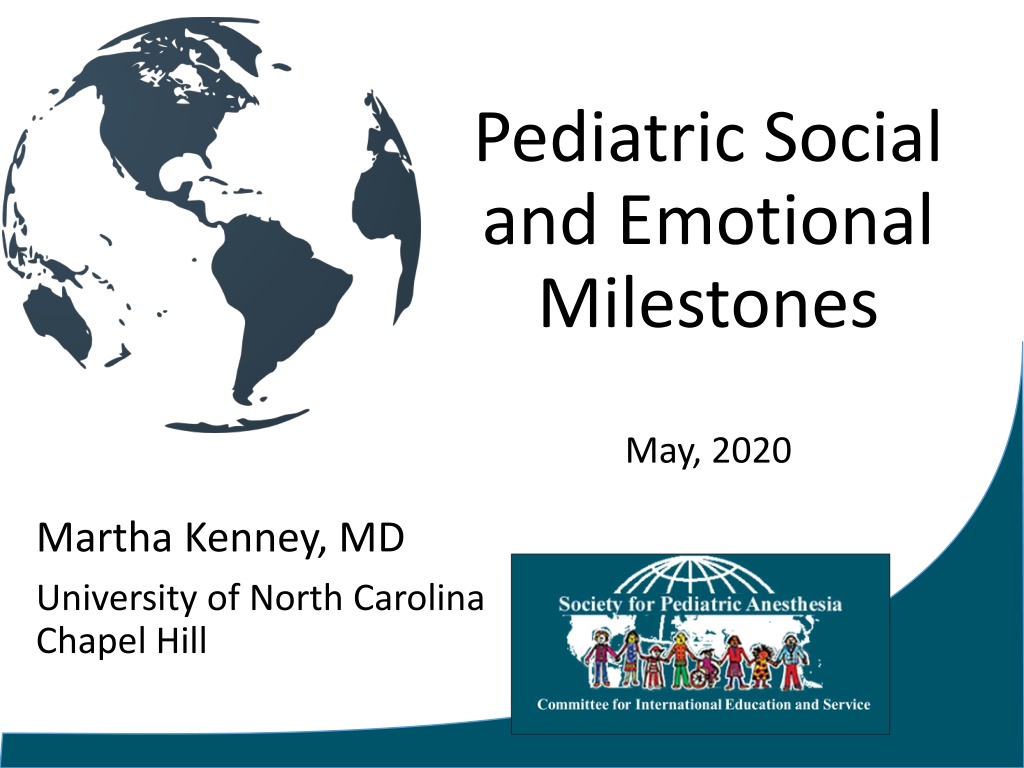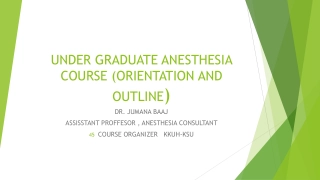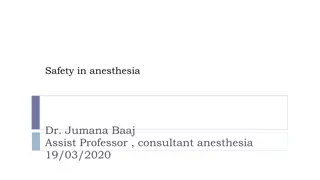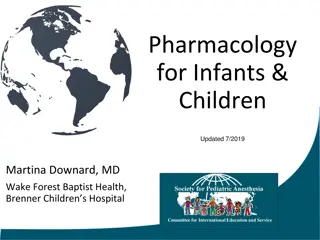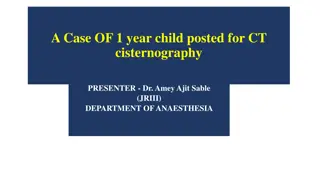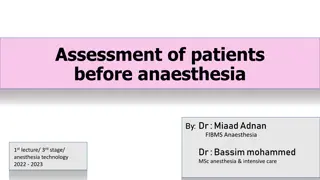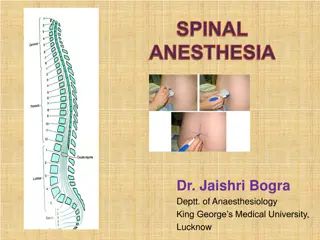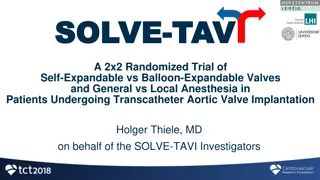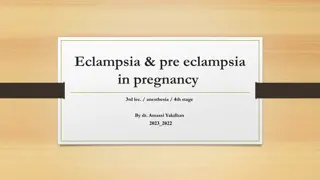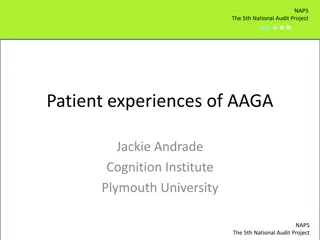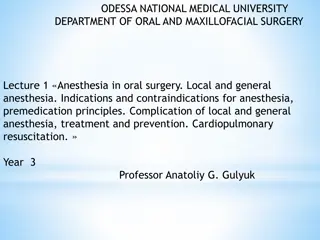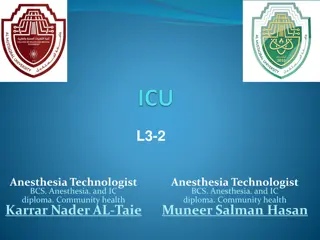Understanding Pediatric Social and Emotional Milestones in Anesthesia
Tailoring preoperative assessment and anesthetic management to a child's developmental level is crucial. Children's responses to stress vary based on their cognitive potential and developmental stage. Incorporating behavioral techniques informed by developmental theories like Piaget's and Erickson's can promote cooperative behavior. Understanding Erikson's stages of psychosocial development can guide addressing preoperative anxiety and postoperative pain effectively. Piaget's stages of learning highlight how children evolve in their thinking processes from birth to adolescence.
- Pediatric anesthesia
- Social and emotional milestones
- Developmental assessment
- Eriksons stages
- Piagets stages
Download Presentation

Please find below an Image/Link to download the presentation.
The content on the website is provided AS IS for your information and personal use only. It may not be sold, licensed, or shared on other websites without obtaining consent from the author. Download presentation by click this link. If you encounter any issues during the download, it is possible that the publisher has removed the file from their server.
E N D
Presentation Transcript
Pediatric Social and Emotional Milestones May, 2020 Martha Kenney, MD University of North Carolina Chapel Hill
Disclosures No relevant financial relationships
Learning Objectives: Understand the clinical relevance of social and emotional milestones in pediatric anesthesia Identify the four major stages of cognitive development Learn to incorporate developmental status in preoperative assessment and induction/anesthetic management Identify disease processes with cognitive and behavioral abnormalities
Understanding Milestones is Important The preoperative assessment and the anesthetic management should be tailored to the child s developmental level Children respond to stress based on their developmental stage and cognitive potential Behavioral techniques can reinforce cooperative behavior in children Various developmental and learning theories (e.g. Piaget and Erickson theories) provide conceptual frameworks for social and emotional milestones
Eriksons Stages of Psychosocial Development Eight stages: Four childhood stages One adolescent stage Three adult stages Can inform approach and techniques for addressing pre-operative anxiety and post-operative pain
Eriksons Stages of Psychosocial Development Stage Age Psychosocial Conflict/Task 1 < 1 Trust vs Mistrust 2 2 - 3 Autonomy vs Shame/doubt 3 3 - 5 Initiative vs Guilt 4 5 - 12 Industry vs Inferiority 5 12 - 18 Identity vs Confusion
Piagets Stages of Learning Sensorimotor: birth to 2 years Learns through senses and actions (looking, touching, mouthing) Pre-operational: 2-7 years Represents things with words, symbols and images Pretend play, egocentrism Concrete operational: 7-11 years Thinking is concrete Logical reasoning applied only to things that can be seen or are real Formal operational: 11 years and older Logical reasoning applied to abstract ideas or hypothetical events
Sensorimotor Stage: Birth to Two Years Important milestones: Social smile at 2-3 months Object permanence between 7 and 9 months: things continue to exist even if they can no longer be seen Stranger anxiety at 9-12 months Limited language skills
Sensorimotor Stage: Birth to Two Years Preoperative assessment Anxiety can be transmitted from parent to child Consider Parental presence at induction for children > 9 months (stranger anxiety) Premedication as needed Allow the child to take a comforting object (e.g. stuffed animal) to the OR Model mask induction with stuffed animal or parent
Sensorimotor Stage: Birth to Two Years Strategies for the perioperative period Touching, swaddling, and cooing can be soothing techniques for infants Distraction with toys or music may be helpful Post-operative pain assessment: Limited language skills
Sensorimotor Stage: Birth to Two Years Use observational and behavioral pain assessment tools Face, Leg, Activity, Cry and Consolability (FLACC) pain scale Wong Baker Faces pain scale By Intermedichbo - Own work, CC BY-SA 4.0, https://commons.wikimedia.org/w/index.php?curid=36231995
Pre-operational Stage: 2-7 Years Key milestones: Rapid language development Magical thinking is used to explain experiences Pretend play is important Thinking is egocentric Difficulty seeing the perspective of others
Pre-operational Stage: 2-7 Years Preoperative Assessment and Induction Rapport building is important Include child in explanations Use storytelling to explain anesthetic experience Allow child to participate in induction (e.g. hold their own mask) Utilize videos, music, and props (for e.g. phones, tablets) as distraction tools
Concrete Operational Stage: 7 - 11 Years Key Milestones Concrete thinkers Increased need for explanation Increased need for participation Based on information from Ginsburg H., Opper S. (1979). Piaget's Theory of Intellectual Development. Prentice Hall, p. 152 . Creative Commons Attribution-Share Alike 3.0 Unported license.
Concrete Operational Stage: 7-11 Years Preoperative assessment and Induction Child should participation in the preoperative discussion - Select a flavor for the mask - Choose a parent to accompany them to the OR Mask induction can be made into a game to decrease situational anxiety
Formal Operational Stage: 11 Years and Older Key milestones: Abstract and hypothetical thinking Increased body awareness Increased independence Peer pressure is significant Based on information from Ginsburg H., Opper S. (1979). Piaget's Theory of Intellectual Development. Prentice Hall, p. 152 . Creative Commons Attribution-Share Alike 3.0 Unported license.
Formal Operational Stage: 11 Years and Older Preoperative Assessment and Induction Allow participation in decision making Solicit preferences: e.g. IV vs. mask induction Obtain assent Respect the need for privacy
Social and Emotional Red Flags Age Red Flag (months) 3 No cooing or gurgling sounds 6 No smile No babbling 12 No reciprocal gestures (pointing, reaching, showing) 15 No single words 18 No pretend play 24 No meaningful two-word phrases 36 Unable to pay attention to a task for 3 minutes
Special Consideration: Autism Autistic children: Perioperative challenges Persistent deficits in social communication and interaction across multiple contexts Restricted, repetitive patterns of behavior, interest, or activities Increased risk for severe anxiety and distress and post-operative behavioral problems High sensitivity to visual, auditory, and tactile stimuli
Special Consideration: Autism Discuss behavioral triggers and past anesthetic experiences with parents/caregivers Communicate with patient using pictures and other visual tools Discuss potential use of restraints with parent/caregivers Minimize waiting time Utilize parental presence during induction
Special Consideration: Attention Deficit Disorder with Hyperactivity Disorder of inattention, hyperactivity and impulsivity - Affects 8-12% of children worldwide - Male:Female ratio of 3:1 Detailed medication history: potential for drug-drug interactions Possible increased anesthetic requirement from stimulant medication
Special Consideration: Trisomy 21 Syndrome Characteristic facial features Mild to severe cognitive impairment Associated organ- specific abnormalities (e.g. congenital heart disease)
Special Consideration: Trisomy 21 Syndrome Most common cause of intellectual disability Strategies for addressing behavioral challenges in the preoperative setting maybe similar to approach with autistic patients
References: 1. Davis, PJ et al. Smith s Anesthesia for Infants and Children. 18th Ed. Philadelphia: Elsevier, 2011. 2. Gerber, RJ et al. Developmental Milestones 3: Social- Emotional Development. Peds in Rev. 2011; 533-536. 3. Holland E, Nelson P. Peds PBLD 1 Social and Emotional Milestones. Anesthesia Toolbox. 2018. 4. Kliegman, RM et al. Nelson Textbook of Pediatrics. 20th Ed. Philadelphia: Elsevier, 2016. 5. McGraw T. Preparing children for the operating room: psychological issues. Can J Anaesth. 1994; 1094-1103. 6. Pappas K, Infosino A. Peds Podcast 3.1. Social and Emotional Milestones. Anesthesia Toolbox. 2017. 7. Stannard D, Krenzischek D. Perianesthesia Nursing Care. 2nd Ed. Burlington: Jones & Bartlett Learning Group, 2018.
